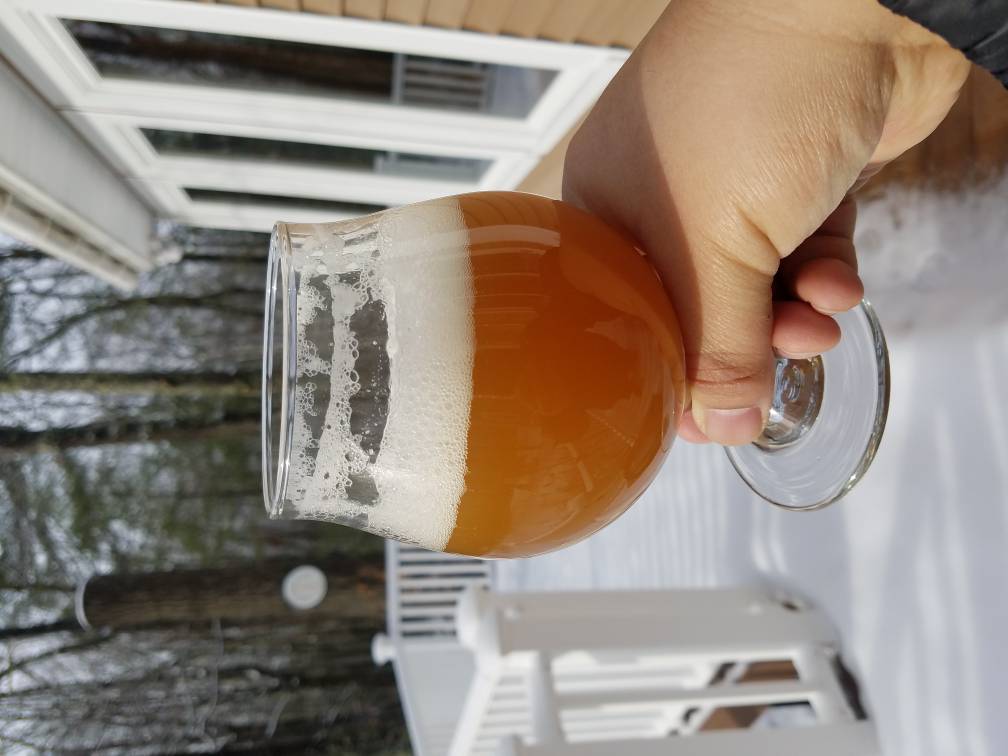Ok, here's my full report on my latest attempt, I'll try to include everything.
5 gal batch, 6 gal into primary
O.G. 1.072
F.G. 1.020 at packaging
Grist/Mash:
73% TF&S Golden Promise
12% Weyermann Carafoam
9% Avangard Munich Light
6% Briess C10
Rising temp mash - mash in at 152F, raise to 159F over 1 hour. Measured mash pH 5.79, cooled sample, raw measurement (this is the convention i always use for reporting pH). Decoction mash out to 176F.
Hops:
No bittering. In fact, no boil hops at all
15 min flameout hop stand with 4 oz Mosaic and 4 oz Citra.
DH1: 2 oz Mosaic, 2 oz Citra, 2 oz El Dorado
DH2: 2 oz Mosaic
Yeast:
15 g S-04, 0.5 g WB-06, 1.0 g T-58. (91/3/6%). This comes out to about 72 g/hL, which is towards the top end of the Fermentis recommendation of 50-80 g/hL. I wanted to go higher because of my somewhat higher O.G. but probably didn't need to.
Water:
Ca: 55 mg/L
Mg: 8 mg/L
Na: 5 mg/L
Cl: 201 mg/L
HCO3: mg/L
K: 211 mg/L
Started from 100% local water and added gypsum and KCl to hit that. No acid additions.
Temp/schedule:
Pitched at 62F and started at a controlled 63F ambient. Added DH1 at 48 hours and raised ambient to 67F at that point. Added DH2 48 hours after that. Packaged on day 8.
Packaging:
Chose to bottle this one instead of kegging due holiday travel requirements. Primed with 28 oz gyle from this same batch, essentially vacuum canned on brew day. Also used 2 g of CBC-1. CO2 transferred from primary carboy to a purged keg and used CO2 to push to my bottle wand. Packaging was 14 days ago today.
Notes/lessons learned:
So first and foremost, there is no clove. Huzzah! Aroma is actually primarily dank/resinous/marijuana-like with supporting tropical fruit and some citrus. As is warms up I get more of the orange/tangerine thing. Flavor is dank and orange-y, with some of that subtle spice coming through as it warms, like Sap. Bitterness is high, likely because of the high bicarbonate/pH, despite the hop-stand-only kettle strategy. It is slightly sweeter and less tart than my last attempt, which is a step in the right direction IMO.
Overall I'm pretty pleased with this batch. It's a lot better than my first attempt. Next time I will make the following changes:
1) up the T-58 to 10% ish, maybe a little more.
2) maybe up the pitch temp slightly, still in the 60s though.
3) Decrease the Munich slightly and maybe replace some of the GP with 2 row or pils
4) adjust the mash pH to the low 5s and maybe acidify my sparge water as well.
View attachment 550967
View attachment 550968


















![Craft A Brew - Safale S-04 Dry Yeast - Fermentis - English Ale Dry Yeast - For English and American Ales and Hard Apple Ciders - Ingredients for Home Brewing - Beer Making Supplies - [1 Pack]](https://m.media-amazon.com/images/I/41fVGNh6JfL._SL500_.jpg)












































